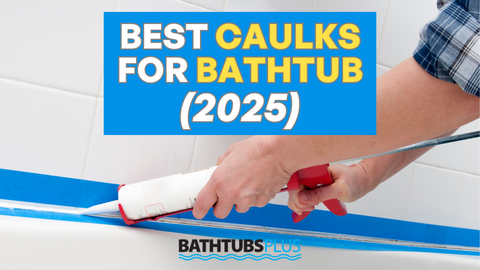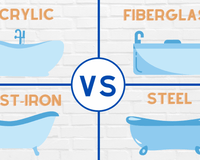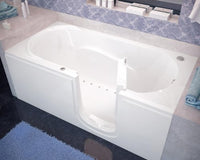COVID-19 has given us more time to stay at home and begin the chores we’ve been putting off– deep cleaning our bathtubs included. With this comes the rise of bathtub cleaning hacks and DIY cleaners online, and people love them because they’re mostly easy to make and budget-friendly.
As much as we love convenience, there's a huge difference between getting the job done and getting the job done right. Without proper research, you might end up damaging your most precious bathtub with these quick fixes and band-aid solutions.
Avoid these bathtub cleaning mistakes to save thousands on installing a new one later:
Mistake # 1: Not properly rinsing your tub every after use

Your bathtub will be a germ-filled basin if you don’t rinse it properly! You soak or rinse off in a bathtub daily, capturing your dead skin, soap scum, bacteria and other nasty stuff you don’t want to be swimming in your bath.
You might think you get the job done by just draining the tub after use, especially when you’re in a hurry (I know, we’re all guilty at some point). The more you practice this bad habit, the more bacteria will stick to the walls of your bathtub. Without proper bathroom hygiene, more than 1,000 bacteria per square inch can grow in your bathtub. [Source: Bustle].
What YOU can do instead
Rinse it properly after use. As simple as it sounds, taking just a minute or two to rinse off your bathtub can significantly remove the debris and prevent its buildup on your tub’s surfaces. This simple practice can also minimize long-term damage that can result from such buildup (i.e. permanent rust stains, caulk deterioration, powdering of the tub surface)
Mistake # 2: Not regularly cleaning your tub regularly

Do you clean your bathroom regularly? Is cleaning your bathtub part of your routine? If not, then you might be slowly damaging your bathtub.
Draining your bathtub water won’t magically wash down all the bacteria and make it sparkly clean again. A filthy bathtub can be a home to mildew, molds and other bacteria that can slowly eat away the caulk surrounding the tub and weaken your tub’s surface.
What YOU can do instead
Having a regular bathtub cleaning routine will not only make your bathtub hygienic; it can also make your bathtub look brand new. You may ask: how often should you clean your bathtub? It’s recommended to disinfect the bathtub weekly, and aim to deep clean it every month, minimum. [Source: Family HandyMan]
When cleaning your bathtub, it’s not enough to scrub the visible dirt and stain. Most of the time, your bathtub’s hidden crannies and crevices– which are hotspots for bacteria– are left uncleaned. Make sure you properly clean the whole bathtub for a squeaky-clean and germ-free environment.
While you’re at it, clean everything in your bathroom including your bathroom walls, floor and especially the shower curtains. Shower curtains are usually neglected when cleaning the bathroom. Make sure to regularly scrub it to take all the nasty stuff away. Trim it as well to match your bathtub. This way, it won’t hit the bathtub and act as an easy breeding ground for mold and mildew.
Mistake #3: Not properly ventilating your room

Your bathtub is a large vessel you fill up with water every use, making it one of the wettest spots in your home. Unrepaired water leaks from its faucets or showers add up to its moisture and high humidity.
Most of the time, we just let the water dry on its own without realizing the moisture already gets under the tub. This eventually leads to serious damages like fungus growth and wood rot on the subfloor. If the damage becomes so severe, your bathtub floor may collapse and crash down to the floor below.
What YOU can do instead
Make sure your tub and your overall bathroom are well-ventilated. It can be in a form of a window to make sure the sun comes in or an exhaust fan to ensure there’s constant air circulation in the room. Every after bath, keep it dry as possible by gently wiping off excess moisture with a soft sponge, microfiber cloth, or squeegee.
Having proper ventilation in place is also essential for safety reasons. When you clean bathrooms, strong cleaning solutions are sometimes needed. Without proper ventilation, working with these chemicals in an enclosed space can be harmful to your lungs and skin.
Mistake #4: Leaving your bath products on the tub’s ledges

The bathtub ledge is a functional space that can hold many of your things while you soak: your favorite candle, a drink, book, and even your bathroom essentials. Nothing bad with utilizing these spaces, but make sure to put back your bath products in their proper storage after use.
When you always leave these products on the ledges, the acids in them can cause permanent stains and marks on your bathtub– ruining your tub’s natural luster and color. They can also cause the water to be trapped on the tub’s surface, accelerating the tub’s water damage and inviting more bacteria.
Be mindful not to put heavy things too, as they may scratch the tub’s outer coating. Worst-case scenario, you drop them and leave a permanent hole in your tub.
What YOU can do instead
The secret really is to keep your bathroom organized so things won’t be littering around. Rather than keeping your soap or shampoo bottles on the ledges, place them somewhere that allows the water to drain away.
If you lack space, there are many sturdy open shelves that you may hang on walls. By doing so, you don’t just maximize your bathroom space, you’re also saving your bathtub from possible damages and repair costs.
Mistake #5: Using the wrong or abrasive tools

It’s satisfying to use hard tools, extremely abrasive brushes or steel wools to scrub your bathtub and remove those stubborn stains. While they may get rid of the problem today, over time they can cause your bathtub to crack and leave permanent marks and scratches that will dull the tub’s surface.
What YOU can do instead
Don’t risk scratching your tub by using harsh cleaning tools like scouring powders, hard cloths, metal scrubbers and other sharp materials, especially if it’s made of acrylic or fiberglass. The safest option is to use nonabrasive cleaners and very soft brushes to clean your tub.
Not sure if your cleaner is safe for use? Rub it. If it’s gritty, it’s probably harsh for your tub. On some occasions where the stain is too stubborn, you may opt for a mildly abrasive cleaner. To prevent unwanted sediments from settling in your tub, rinse it off with bath oils.
Mistake #6: Using harsh cleaning solutions or chemicals

It's important to note that simply removing dirt and particles on your tub’s surface is not the same as disinfecting them to kill viruses and bacteria. Infamously, bathtubs are magnets for fungus and impurities. At some point, you’ll need a good cleaning solution to keep its charm and cleanliness. Still, using abrasive and stringent cleaners might do more harm than good to your tub.
There are three usual problems with cleaning solutions. 1) You think they’re mild but they’re actually harsh for the tub’s material. 2) You think they’re effective just because they removed the stain for now but the after-effect is damaging. 3) You think using too much cleaning product is better.
What YOU can do instead
There’s an overwhelming option of cleaning solutions out there, all with varying potencies and toxicities. So which cleaning solution is the best for your bathtub? Depending on the price and ease of cleaning, the decision is still yours to make.
However, when dealing with chemicals to clean your tub, it’s best to familiarize yourself with the substance’s ingredients and its compatibility with your tub’s material.
If it’s made of stone resin, you may want to stay away from acidic cleaners to prevent corrosive damage. This includes vinegar– a typical DIY cleaning solution– and its partner baking soda, as they may damage your tub’s enamel coating.
Other harsh chemicals to avoid include paint thinners, solvents, nail polish remover, gasoline, kerosene, and so on.
Surprisingly, dish soap is one of the safest and most effective cleaning products. Its gentle nature makes it a good choice for cleaning surfaces other than dishes, like bathroom tiles, walls and even your bathtub. [Source: The Spruce].
Clean your tub as much as you enjoy it
You may own the most beautiful bathtub, but if you’re not disciplined and diligent enough to take good care of it, your bathtub will easily lose its beauty.
Cleaning your tub regularly may be a tiring task, but it can definitely save you from more effortful cleaning, or worse, serious bathtub damage in the future.
After all, you and your family deserve a clean and stress-free bath every day.
Want to upgrade your bathroom without cutting your budget? Read this article: Easy and Affordable Bath Upgrades for a Fancy, Functional Bathroom











